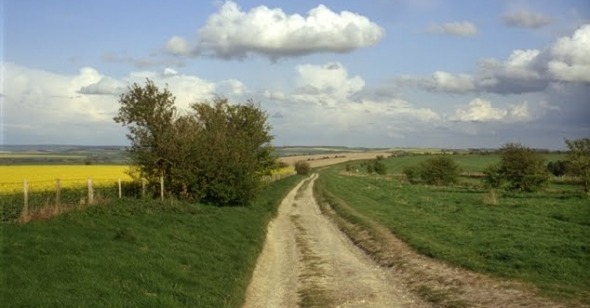Home Fires
by Farihah Zaman
Robinson in Ruins
Dir. Patrick Keiller, UK, no distributor
Robinson is a meticulous man. A tireless researcher, explorer, and academic with a sharp eye and a quick tongue, he’s a man whose curiosity and drive lead him on a quest to take photographs and collect historical data on the sometimes ruined towns throughout rural South England, just days after his unexplained release from prison. Robinson also happens to be the fictional alter ego of British filmmaker Patrick Keiller, and the protagonist of Keiller’s similarly avant-garde cine-essay films London and the cheekily titled Robinson in Space. In his third film of the series, Robinson in Ruins, Keiller uses his trademark technique of presenting the videos and photographs that his protagonist has collected, never allowing him to actually appear in the film, but divulging his collected data and varied thoughts through the voice of an elegant narrator (in this case the dulcet-toned Vanessa Redgrave).
Keiller has said that if London is concerned with the problem of that city, and Robinson in Space is concerned with the problem of England, Robinson in Ruins is concerned with the problem of dwelling. This concept is explored in myriad ways as Keiller demonstrates that the answer to the question “where do you live?” refers not only to the building one calls home, which has in and of itself been a universal preoccupation since the domination of agrarian society, but also to language, culture, community—one’s place in the world and one of the foundations of human identity. The images run the gamut from street signage to abandoned grocery stores to a long, meditative moment with a tractor in a wheat field, so many quotidian artifacts of life that are dramatically recast as Keiller-as-narrator-as-Robinson makes extrapolations about everything from local governance and census statistics, to the global economy, to Neo-Darwinism, to the struggle of nature, to the ruination left in the wake of the industrial age. Keiller manages to construct a film that, while comprised entirely of images of the near past and present, creates a foreboding sense of our dystopian postindustrial future.
Though Robinson never once appears onscreen, he is nevertheless a compelling and well drawn character. Seeing the world through the images that he created induces a feeling of greater intimacy with him than the traditional cinematic set up of relating face to face ever could have. However this direct immersion into Robinson’s whirlwind brain is complicated by the volume and fluid motion of information, and the film’s mercurial relationship between text and imagery. At times the voiceover works in tandem with the image, such as when Redgrave discusses the region’s former opium trade over a serene shot of a poppy field, or simply calls attention to otherwise overlooked details, such as the indigenous lichen on an old highway sign. In other scenes, however, the narration is a strange counterpoint that forces one to reconsider the image, such as a particularly memorable scene of a spider building a web while the narrator discusses capitalism and the U.S. stock market. The juxtaposition is not quite as paradoxically on-the-nose as it may seem; in the context of the film as a whole, that pairing does not just pit nature against industry, but dredges up deeper issues of industriousness and labor, the presence of those qualities in nature itself, and, returning to the theme of dwelling, the idea of what constitutes a safe and secure home.
The techniques Keiller uses in Robinson in Ruins feel both fresh and part of a tradition, and tempts comparison to several other filmmakers’ works, such as James Benning, with his distinctive ruminations on landscape, and Peter Greenway, whose Tulse Luper series also tells a story through the use of structuralism and an obsessive, sturdily intrepid alter-ego. The film is also unexpectedly reminiscent of the work of Guy Debord, also known for using intellectually dense text over a barrage of static shots, particularly archival footage, such as in his best known film, La société du spectacle. Both films depend on the tension or revelation that results from the pairing of text and image, and both can leave the audience overwhelmed, unable to process the exact meaning of each phrase, allowing rather a list of impressions.
However, while Debord uses the distinctly avant-garde technique to try and shock the audience out of a bourgeois mentality that he believes pervades even the process of watching film, Keiller’s message is less obvious, more of an experience or a sensation, and a far less abrasive one at that. While Debord’s films are classic, groundbreaking pieces of experimental film, they are also intentionally obvious, a kind of intellectual agitprop. In Robinson in Ruins Keiller fascinatingly bends a seemingly inherently aggressive filmmaking technique to create something far more subtle, meditative, and ideologically complex, inspiring not violent action but respectful reflection.
